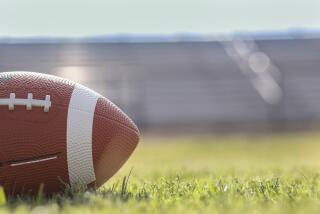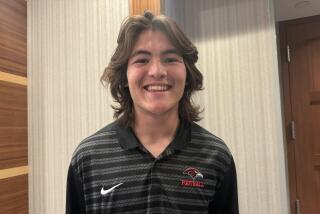This Coach Set the Standard for the Rest : Long Hours and Innovation Made Anaheim’s Van Hoorebeke Unique
- Share via
Clare Van Hoorebeke was a man ahead of his time. The most innovative, respected and technologically advanced football coach in Orange County history, he walked the sidelines wearing a beat-up blue cap, sweat pants and a tattered letterman’s jacket.
From the time he began coaching at Anaheim in 1950 until he retired in 1972, he was married to football, putting in tireless hours of preparation at a time when coaching could make a profound difference.
He was among the pioneers of studying game film, driving to Hollywood after games--it was the only place to get the movie film developed--and talking with lower-level coaches who did the advance scouting (also a novelty) during the wait.
Sideline earphones, weight training, coaching specialists, larger staffs and sending them to clinics--all staples in today’s programs--were virtually nonexistent before Van Hoorebeke introduced them. He revolutionized the manner in which coaches coached, and had the numbers to support his theories: His 190-49-10 record in 23 seasons was responsible for two Southern Section championships, 16 Sunset League titles and 17 section playoff appearances when only first-place teams were guaranteed a playoff berth.
Two coaches, Dick Hill (205-97-4) and Herb Hill (191-112-11), have since surpassed Van Hoorebeke’s victory total, but don’t come close to his 78.3 winning percentage.
Some of the county’s best players were Van Hoorebeke products, including fullback Tom Fitzpatrick, the 1967 section player of the year, tight end Gerry [Moon] Mullins, who went on to win four Super Bowl titles with the Pittsburgh Steelers, and running back Mickey Flynn, a local legend. According to those who played for him, when Van Hoorebeke got a 14-point lead, he would begin replacing his starters in the lineup.
“The philosophy wasn’t to run up the score, but to get people in the game; he was always building for the future with his teams,” said Villa Park Coach Pat Mahoney, who played on the 1966 and ’68 teams. “He would tell us we were going to get beat, then win by 20 and he’d tell us we did terrible. That was the philosophy back then. You were expected to win.”
His preparation, discipline and pursuit of perfection filtered to other programs county-wide.
Players learned to determine how long practice would be by counting how many cigars Van Hoorebeke--nicknamed the Dutch Master--had in his shirt pocket. Brea Olinda Coach John Looney, who was on Van Hoorebeke’s final team, said 30 40-yard dashes--if not more--at the end of practice were standard.
Van Hoorebeke’s love of studying game film also created some legendary practices. Four hours in the film room--as a team--was not unusual, and few escaped unscathed.
There was one position he didn’t have much need for; he once said a wide receiver “is not a football player, he’s just a guy who stands way out there.”
Still, Anaheim football made good theater, and people loved to watch. Former Anaheim City Manager Keith Murdoch said in 1978, “On Friday night, the stores closed because the owners and the customers were out watching Anaheim play football.”
The two largest crowds to watch a section football game involved Van Hoorebeke, the 1956 Major Division Final against Downey (41,383) and the 1966 AAAA Division Semifinal against Mater Dei (33,374).
Reportedly, crowds of only 10,000 were said to disappoint him.
“Everyone liked him, from the hoods to the athletes,” Looney said. “He’d walk across campus and stop and talk to the hoods for 15 minutes and they’d be laughing.”
Van Hoorebeke died of a heart attack in 1978 in the Anaheim training room. His funeral was held at Melodyland. The place was packed.
Once again, it seemed the whole town turned out.
More to Read
Get our high school sports newsletter
Prep Rally is devoted to the SoCal high school sports experience, bringing you scores, stories and a behind-the-scenes look at what makes prep sports so popular.
You may occasionally receive promotional content from the Los Angeles Times.






